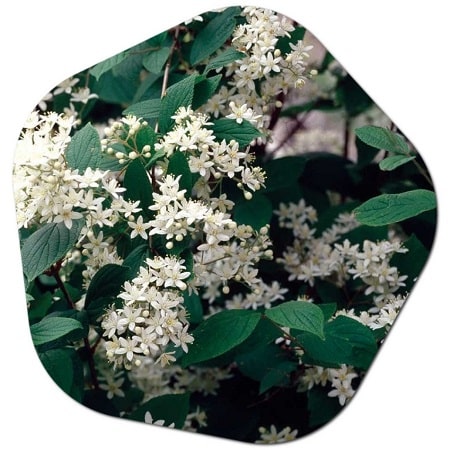The Terry Tassel plant is breathtaking, forming a broad, arching crown and producing countless flowers on its graceful shoots. The fragrant, bell-shaped flowers bloom in spring and the plant displays this jaw-dropping display for up to 3 weeks. It is very effortless with its maintenance-free structure that is easily shaped by pruning.
Deutzia is a versatile and attractive shrub that can be grown in a variety of garden settings. To determine the best place to plant Deutzia, consider the following factors:
- Sunlight: Deutzia generally thrives in full to partial sun. In regions with hot summers, it may benefit from some afternoon shade. Ensure that the location receives at least 4-6 hours of sunlight per day.
- Soil: Deutzia prefers well-draining, fertile soil. It can tolerate different soil types but performs best in soil that is enriched with organic matter. Good drainage is crucial to prevent root rot.
- Location: Choose a location in your garden or landscape that allows the Deutzia shrub to grow to its full mature size without overcrowding. Adequate spacing between Deutzia plants and other garden elements is essential.
- Protection from Harsh Elements: Consider planting Deutzia in a location that provides some protection from strong winds or harsh winter conditions. Sheltered areas can help the plant thrive.
- Companion Plants: Deutzia can be paired with other shrubs, perennials, or annuals to create an aesthetically pleasing garden design. Consider its height and bloom time when selecting companion plants.
- Fragrance Enjoyment: Some Deutzia varieties have fragrant flowers. Planting them near walkways, patios, or outdoor seating areas allows you to appreciate their fragrance.
- Naturalized Areas: Deutzia can be used in naturalized or wilder garden settings, especially in woodland gardens or along the edges of natural areas.
- Pruning Space: Keep in mind that Deutzia may require occasional pruning to maintain its shape and size. Make sure you have enough space around the shrub for pruning.
- Local Climate: Consider your local climate conditions when choosing the best place for Deutzia. Some varieties are more cold-hardy than others, so select one that suits your region.

Overall, the best place to plant Deutzia will depend on your specific garden or landscape, taking into account factors like sunlight, soil quality, protection from elements, and aesthetic considerations. Deutzia’s versatility makes it a valuable addition to various garden styles, from formal to informal, and it can be used in mixed borders, shrub borders, or as a focal point in your landscape.
What is the growth of deutzia?
Deutzia is a genus of deciduous or semi-evergreen shrubs known for their attractive foliage and delicate flowers. The growth pattern of Deutzia can vary depending on the specific species or cultivar, but here are some general characteristics of Deutzia growth:
- Size: Deutzia shrubs typically range in size from 2 to 10 feet (0.6 to 3 meters) in height, with a similar spread. The size can vary depending on the species and cultivar.
- Growth Rate: Deutzia shrubs have a moderate growth rate. They are not particularly fast-growing but are generally not slow-growing either. With proper care, you can expect them to fill out and mature over several years.
- Branching: Deutzia shrubs have a bushy and branching growth habit, which gives them a full and attractive appearance.
- Foliage: The leaves of Deutzia are typically simple, opposite, and lance-shaped. The foliage is often green, but some species may have variegated leaves.
- Flowers: Deutzia produces clusters of small, tubular, or bell-shaped flowers in the spring or early summer. The flowers are usually white or pink and can be quite showy.
- Fruit: After flowering, some Deutzia species may produce small, inconspicuous fruit capsules, but these are not a prominent feature of the plant.
- Winter Appearance: In colder climates, Deutzia is deciduous, meaning it sheds its leaves in the fall and remains bare during the winter. In milder regions, some Deutzia species may retain their leaves as semi-evergreen shrubs.
- Pruning: Pruning Deutzia after it has finished flowering helps maintain its shape and encourage new growth. You can also selectively thin out branches to improve air circulation.
- Adaptability: Deutzia is adaptable to a range of soil types and can thrive in different light conditions, from full sun to partial shade.
The specific growth characteristics and appearance of Deutzia shrubs can vary depending on the species and variety you choose to plant. Be sure to select a Deutzia cultivar that suits your garden or landscape design and provide appropriate care to help it reach its full potential.
